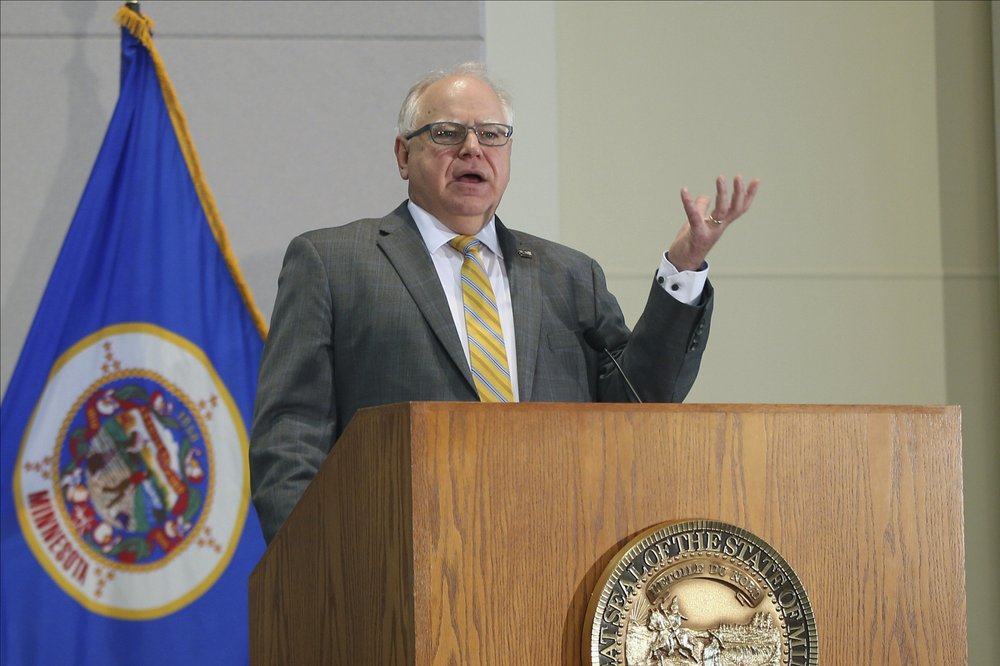Coronavirus
WATCH: Minnesota governor announces launch of smartphone app to slow spread of COVID-19

MINNEAPOLIS (AP) — Gov. Tim Walz and other Minnesota officials urged residents Monday to download a free app for their smartphones that will notify them if someone who’s been near them later tests positive for the coronavirus and will allow them to warn others anonymously if they test positive themselves.
Walz also said he plans to call a special legislative session to pass a relief package to help small businesses cope with the impacts of his moves last week to tighten restrictions to slow the spread of the virus, which included a four-week closure of restaurants and bars, except for takeout and delivery, and a similar shutdown of gyms and amateur sporting events.
“It’s absolutely critical that we get something quickly to these businesses, we get something that makes a material difference to them and bridges the gap until the federal government can do what they need to do,” the Democratic governor said.
Walz told reporters that he plans to announce details Tuesday, but that the proposals will include sales tax forgiveness for businesses that sell food and beverages; waiving state licensing fees; direct relief for individual workers; grants to provide food to health care workers, homeless shelters and long-term care facilities; a state tax credit for food donations by the hospitality industry; and lifting the expiration date on a state COVID-19 relief fund.
The governor said he’s been working on details with Democratic House Majority Leader Ryan Winkler and the business community. But he acknowledged that there was no deal yet, and that he had yet to consult with Republican leaders
Tarek Tomes, the state’s information technology commissioner, stressed that using the COVIDaware MN app is voluntary, and that the system contains ample privacy safeguards for those who opt in. It uses exposure notification technology developed by Google and Apple that is already being used under different names in around 20 other states and 35 countries around the world to try to slow the spread of COVID-19.
“If communities are willing to adopt the app, use it to report positive test results and follow health recommendations when notified of an exposure, this app can help us return to many of the activities we miss so much, and save lives,” Tomes said.
People can download the app from Apple’s App Store for iPhones or Google Play for Android phones. It uses Bluetooth technology to detect when a user has been within 6 feet (1.8 meters) of another user for 15 minutes, which is the federal definition of close contact. Anyone who tests positive will now be asked by contact tracers if they’re using the app. If they are, they’ll get a verification code to enter into the app that will trigger alerts to every other user who’s been that close to them in the preceding two weeks.
The app doesn’t tell a user to whom they were exposed, where or precisely when. But it then provides users information on how to get tested and how to keep themselves and people around them safe, including self-quarantining for 14 days.
Tomes said the system is based on anonymous keys, which are random numbers that change frequently. It does not use any information that would identify a user, nor does it share users’ identifying information with Apple, Google or the state. It does not use GPS or any other technology that would track a user’s location. The keys are deleted after two weeks.
The app will supplement the state’s contact tracing efforts and will flag exposures that are now difficult to trace because people often don’t know where or from whom they contracted the virus, said Kris Ehresmann, the infectious disease director at the Minnesota Department of Health. She said the department is working with universities that are eager to promote the app within their communities.
Virginia in August became the first state to launch the system. Colorado was the most recent before Minnesota. More than 1 million people in Colorado opted in within its first couple weeks, Tomes said. How useful it becomes in Minnesota will depend on how many people participate, but he said an Oxford University study found that an adoption rate as low as 15% could reduce the spread by about the same amount.
Penetration in some European counties quickly reached 20% to 35%, said Ramesh Raskar, founder of the PathCheck Foundation, a spinoff from the Massachusetts Institute of Technology, which is promoting the technology and helped develop the application for Minnesota.
The Minnesota Department of Health on Monday reported 24 more COVID-19 deaths and 6,353 new coronavirus infections, raising the totals for pandemic to 3,265 deaths and 276,500 cases. Monday’s numbers tend to be lower than in the rest of the week because of less testing on weekends. Ehresmann said she expects the state to top 300,000 cases around Thanksgiving. Minnesota hospitals were treating 1,778 people for COVID-19 as of Monday, including 364 in intensive care.
Also Monday, FightCovidMN — a partnership of the state’s hospitals, care systems, health plans and other groups — launched an edgy public service announcement campaign, “COVID-19 Isn’t Taking A Holiday,” to urge Minnesotans to mask up, keep their distance and fight community spread.
“We’re sure it’s good, but is Grandma’s pumpkin pie really to die for?” asks one of the spots.

